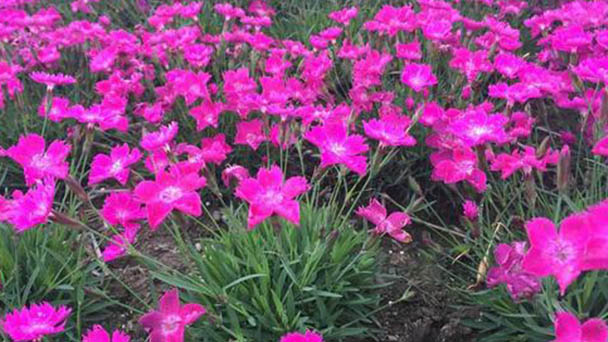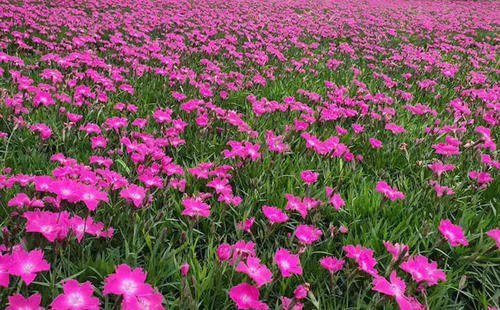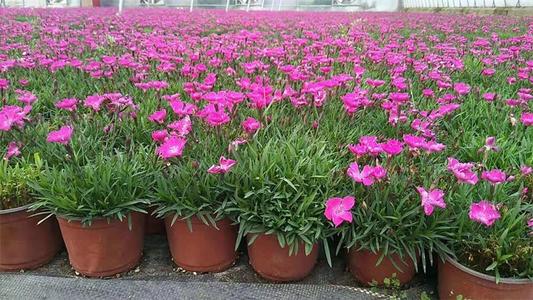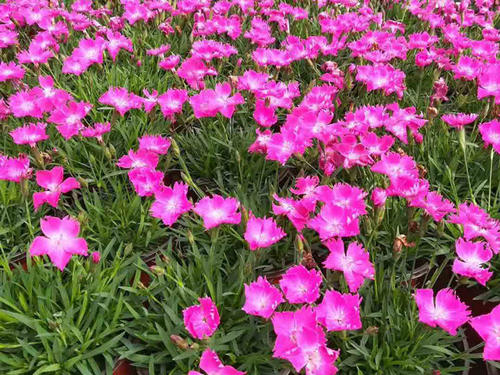Carthusian pink profile
Written by Maggie
Jan 14 2021

Carthusian Pink, scientific name Dianthus carthusianorum, belongs to the order Caryophyllus and grows in dry places, grasslands and open woodlands. Except Greece, throughout the Mediterranean region, it is also widely distributed in central and western Europe.
Carthusian Pink picture

Carthusian Pink morphological characteristics
Carthusian Pink is glabrous, with diversity, basal leaves grass - like a cluster. A sheath is formed at the junction of the stem and leaf, wider in diameter than the stem. Flowers are fascicled, calyx cylindrical, slightly contracted at apex. As in all bryophytes, a series of opposite bracts, about half the length of the calyx, surrounds the calyx. Flowers are veined, 20 -- 30mm in diameter, dark pink, petals 5, serrate.
Carthusian Pink growing environment
Carthusian Pink grows in dry places, grasslands and open woodlands, and prefers a cool environment.

Carthusian Pink distribution range
Except Greece, carthusian pink is throughout the Mediterranean region; It is also widely distributed in central and western Europe.
Carthusian Pink propagation methods
Cutting propagation, sowing propagation and splitting propagation can be carried out. When sowing, the most suitable germination temperature for Carthusian Pink seeds is 21-22 ℃, so the time is generally in September. Prepare pot soil and water well the day before. Carthusian Pink's seeds are small and germinate easily, so you can skip the soaking step. Cuttage is carried out in October or 2~3 months generally, the northern area is suggested to be carried out indoors. Splitting refers to the reproduction of old plants, which is carried out in the fall or early spring.
Carthusian Pink growing methods
Carthusian Pink is easy to grow. Fermented organic fertilizers can be used as a base fertilizer. After planting, it can be watered with water. This is basically irrational.When flowers bloom or die, prune the dead flowers to avoid seed formation. Pruning can help Carthusian Pink bloom again. Of course, if you want to harvest seeds, you can also not prune, humidity can be top dressing, the overall management of planting is more arbitrary. It doesn't take much effort. Potted soil should be loose, ventilated, fertilizer. Divided into garden soil + river sand + leaf rot soil according to 1:1:1, or peat soil + perlite + leaf rot soil according to 1:1:1.
Potted Carthusian Pink should be given more light and can be grown on sunny southern balconies with NPK applied every 7-10 days during growth. Cut off the flowers as soon as they are gone. Because the plant type of carnation is relatively low, do not prune branches when pruning, as long as the residual flowers can be pruned. Carthusian Pink does perform well compared to other dianthus species. Carthusian Pink can be said to be a better breed. Plant one if you like, and you'll see flowers all summer long.

Latest Updated
- Benefits of Bugleweed - 7 Science-backed Health Benefits
- Bugleweed Dangers & Side Effects - Is It Poisonous?
- How to Plant Evergreen Trees - What You Should Know
- When to Plant Evergreens - Grow Guide for Evergreen Trees
- 12 Wonderful Evergreen Shrubs for Your Garden
- 12 Popular Evergreen Plants with Pictures for Beginners
- When And How To Prune A Lilac Bush Like a Pro
- How to Grow & Care for Lilac Vine (Hardenbergia Violacea)
- Japanese Lilac Tree (Syringa Reticulata) Care & Propagation Guide
- Shumard Oak Pros and Cons - What to Know
Popular Articles
- Winter maintenance of Antirrhinum Majus
- How to Grow Terminalia Mantaly Tree
- How to Grow and Care for Crossostephium Chinense
- How to grow Antirrhinum Majus in spring
- Peristeria Elata (Dove Orchid) Profile: Info & Care Guide
- Underwatered Snake Plant (Sansevieria Trifasciata) - Signs And How To Fix
- How to Care for Brazilian Jasmine Plant (Mandevilla Sanderi)
- How to Grow & Care for Graptopetalum Purple Delight in Summer
- Rosa Chinensis (China Rose): Plant Growing & Care Tips
- How to Care for Baby Sun Rose (Aptenia Cordifolia)